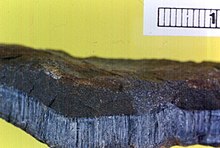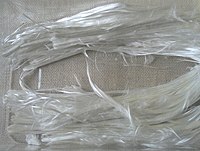Asbestos
From Wikipedia, the free encyclopedia
Asbestos (from Greek ἄσβεστος meaning "unquenchable" or "inextinguishable") is a set of six naturally occurring silicate minerals exploited commercially for their desirable physical properties. They all have in common their asbestiform habit, long, (1:20) thin fibrous crystals. The inhalation of asbestos fibres can cause serious illnesses, including malignant lung cancer, mesothelioma (a formerly rare cancer strongly associated with exposure to asbestos), and asbestosis (a type of pneumoconiosis). Since January 1, 2005, the European Union has banned all use of asbestos[1] and extraction, manufacture and processing of asbestos products.[2]
For environmental samples, one must normally resort to electron microscopy for positive identification.[3]However today gravimetric and PCM/PLM techniques are employed, which cannot readily identify the smallest, most hazardous, fibers. These techniques being limited to PM10 particulate size evaluation which completely ignores ultrafine particles (UFPs).
Asbestos became increasingly popular among manufacturers and builders in the late 19th century because of its sound absorption, tensile strength, and its resistance to heat, electrical and chemical damage. When asbestos is used for its resistance to fire or heat, the fibres are often mixed with cementor woven into fabric or mats. Asbestos was used in some products for its heat resistance, and in the past was used on electric oven and hotplate wiring for its electrical insulation at elevated temperature, and in buildings for its flame-retardant and insulating properties, tensile strength, flexibility, and resistance to chemicals.
[edit]Types and associated fibres
Six minerals are defined by the United States Environmental Protection Agency as "asbestos" including that belonging to the serpentine class chrysotile and that belonging to the amphibole class amosite,crocidolite, tremolite, anthophyllite and actinolite.
There is an important distinction to be made between serpentine and amphibole asbestos due to differences in their chemical composition and their degree of potency as a health hazard when inhaled[4].






















.jpg)





.jpg)

.jpg)









.jpg)

.jpg)














.jpg)


.jpg)






























































































































































































































.jpg)

.jpg)











.jpg)























































.jpg)
















.jpg)













































































































































.jpg)

























No comments:
Post a Comment